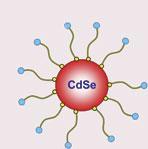In a useful application of nanotechnology Spanish researchers have developed a sensitive toxic-cyanide sensor.

Nanometre-sized low-dimensional semiconductors known as quantum dots (QDs), look promising for numerous applications. However, to date the exploitation of QDs has mainly concentrated on optical imaging in biology and developments in optoelectronics.
With their extensive experience in luminescence sensing, Alfredo Sanz-Medel and his colleagues at the University of Oviedo reasoned that QDs could also be used in chemical sensing. They first modified the surface of cadmium selenide QDs to make them water soluble and then examined their properties in aqueous solution. Not only is the luminescence emission of their modified QDs very sensitive to the presence of even very low concentrations of cyanide ions in aqueous solution but it is also selective for the cyanide ion over other common anions.
Sanz-Medel has big plans for the future. ’Efforts should be directed to the field of surface modification of luminescent QDs (aiming at synthesising new sensing reagents with high specificity for a variety of chemical species) and in their immobilisation onto or into appropriate solid surfaces (avoiding their aggregation) in order to produce robust and reliable optical nanoprobes.’
Caroline Evans
References
<man>b414858d</man>






No comments yet